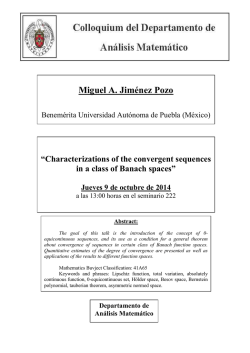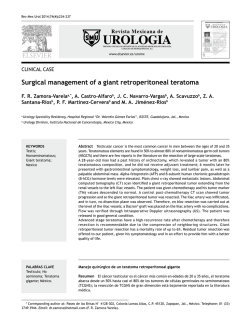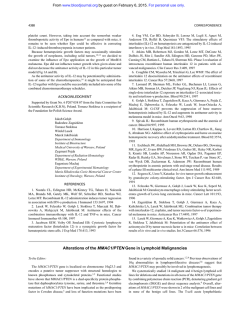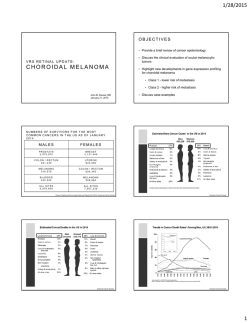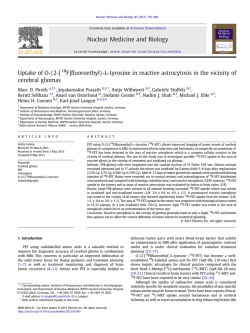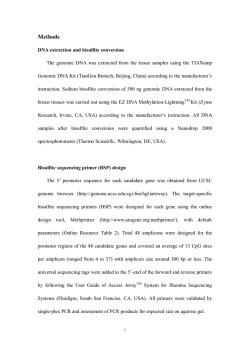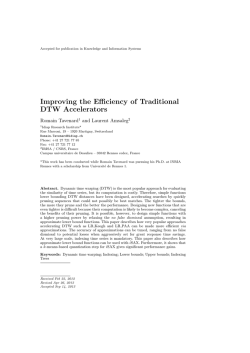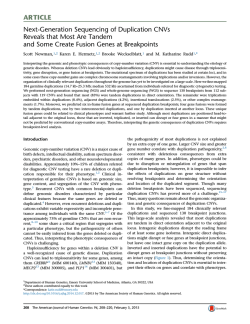
1 2 3 4 5 6 7 8 Zombies in TCGA 9 10 Daniel DiMaio 11 Department
JVI Accepted Manuscript Posted Online 28 January 2015 J. Virol. doi:10.1128/JVI.00170-15 Copyright © 2015, American Society for Microbiology. All Rights Reserved. 1 2 3 4 5 6 7 8 9 Zombies in TCGA 10 11 Daniel DiMaio 12 Department of Genetics 13 Yale School of Medicine 14 15 Abstract 16 Next-generation sequencing results obtained to detect somatic mutations in human cancers can 17 also be searched for viruses that contribute to cancer. Recently, human papillomavirus 18 RNA 18 was detected in tumor types not typically associated with HPV infection. Analyses reported in 19 this issue of Journal of Virology demonstrate that the apparent presence of HPV18 RNA in these 20 atypical tumors is due in at least some cases to contamination of samples with HeLa cells, which 21 harbor HPV18. 22 23 HeLa cells are the zombies of biomedical research. They refuse to die.1 The extracorporeal existence of HeLa cells began on February 8, 1951, with their 24 isolation from the cervical epidermoid carcinoma of a patient named Henrietta Lacks. These 25 cells continue to propagate in vitro more than half a century after Mrs. Lacks died of her disease 26 [1], the first human cancer cells successfully grown long-term in the laboratory. HeLa cells 27 proved to be a great boon to biomedical research, with much of our understanding of mammalian 28 cells and cancer resulting from studies of HeLa cells. One major advance fueled by these cells 29 was the discovery by Harald zur Hausen and his colleagues that cervical cancer cells and cell 30 lines including HeLa cells invariably harbor human papillomavirus (HPV) DNA, usually 31 integrated at random sites in the cancer cell genome, the first substantive evidence linking HPV 32 to this disease [2,3]. Further studies showed that cervical cancer cells express HPV oncogenes, 33 which inactivate cellular tumor suppressor pathways, and that ongoing expression of these 34 oncogenes is required to maintain the transformed state of the cells [4-6]. In the case of HeLa 35 cells, HPV type 18 is the culprit. 36 The first reincarnation of HeLa cells was recognized in the late 1960s with the discovery 37 that many cultured cell lines of various cell types were not as advertised. Rather they were HeLa 38 cells, which had contaminated the other cells and taken over the cultures because of their robust 39 growth properties [7,8]. In some cases, this error invalidated years of work and volumes of 40 conclusions. You would have thought we would have learned our lesson. 41 42 1 43 indefinitely. For example, see the post by “Zombie Hunter Sam” in The Undead Report, 44 http://www.undeadreport.com/2007/11/immortal-cells-zombie-cancer-of-mankind/ Other commenters have likened HeLa cells to Zombies because of their ability to grow 45 The latest (but I suspect not the last) reincarnation of HeLa cells is reported in this issue 46 of the Journal of Virology with the discovery by James Pipas and collaborators at the University 47 of Pittsburgh that HeLa cell RNA sequences lurk in the results of large-scale sequencing efforts 48 used to characterize cancer genomes [9]. 49 Since the discovery 100 years ago by Ellermann and Bang and by Rous that viruses can 50 cause certain cancers in animals, tumor virology has been motivated by the belief that viruses are 51 responsible for some human cancer [10,11]. Indeed, the search for human tumor viruses has 52 identified a handful of viruses that play causal roles in up to 15% of all human cancers including 53 common cancers such as liver cancer (hepatitis B virus and hepatitis C virus) and cervical cancer 54 (high-risk HPV) [12]. The development of safe and effective vaccines that can prevent infection 55 and hence carcinogenesis by these viruses is a major public health advance and has inspired 56 searches for additional viruses involved in human cancer. In addition, the study of tumor viruses 57 continues to generate profound insights into many aspects of biology including cell cycle control, 58 signal transduction, basic mechanisms of gene expression, fundamental features of cell biology 59 and immunology, and carcinogenesis. 60 The search for tumor viruses used to rely primarily on classic virologic and 61 epidemiologic approaches, but the two most recently discovered human tumor viruses, Kaposi 62 Sarcoma herpesvirus and Merkel Cell polyomavirus, were first identified by nucleotide sequence 63 analysis of tumors [13,14]. Of course, sequence-based virus discovery has its hazards. The 64 notorious xenotropic murine leukemia virus-related virus, XMRV, discovered in hereditary 65 prostate cancer and later studied as a possible cause of chronic fatigue syndrome, turned out to 66 be a laboratory recombinant with no apparent bearing on human health [15-17]. Nevertheless, 67 given the tsunami of cancer cell DNA and RNA sequences generated by The Cancer Genome 68 Atlas (TCGA) and other large-scale cancer sequencing efforts, enterprising scientists are mining 69 these data for new (or old) viruses that may play a role in cancer formation. 70 These studies apparently bore fruit with recent findings published in Nature 71 Communications and Human Genomics, reporting the detection of HPV18 RNA in the sequences 72 of colorectal cancers, as well as in normal kidney samples [18,19]. However, neither colorectal 73 nor kidney tissue is typically associated with HPV infection, and prior dedicated searches for 74 HPV DNA in colorectal tumors failed to provide convincing evidence of an association [20]. 75 Pipas and colleagues confirmed these observations in TCGA data, including some of the 76 individual tumors analyzed in the prior publications, but noticed that the number of HPV18 RNA 77 sequence reads in these atypical tumors were much lower than the number of reads in cervical 78 cancer specimens and, unlike the cervical cancers, were present in RNAseq data only, not in 79 whole exome sequencing [9]. These finding raised suspicions, so they examined in more detail 80 the HPV18 sequences reported to be present in these cancers and compared them to the well- 81 characterized HPV18 sequences in HeLa cells. They came to the startling, or perhaps not so 82 startling, conclusions that the viral RNA sequences deposited in TCGA were identical to HPV18 83 RNA from HeLa cells and hence that these were not novel tumor virus sequences at all, but 84 rather, once again, evidence of HeLa cell contamination. The data were compelling: portions of 85 the viral genome deleted in HeLa cells were also deleted in the new cancers; single nucleotide 86 polymorphisms (SNPs) present in the viral sequences in the new cancers were identical to the 87 known polymorphisms in the strain of HPV18 present in HeLa cells and not to other known HPV 88 strains; and most damningly, some of the viral/cellular RNA junction fragments at the sites of 89 HPV18 integration in the atypical tumor samples were identical to the integration sites in HeLa 90 cells. In contrast, HPV18 sequences from independent bone fide cervical cancers did not display 91 these characteristics. Further sleuthing showed that the suspect HPV18 sequences were all 92 acquired on specific dates at only two sequencing centers on sequence runs on specific 93 sequencing machines. 94 The conclusion is inescapable: the HPV18 sequences present in the databases are in fact 95 disembodied evidence of HeLa cell contamination. But the problem is not restricted to HeLa 96 cells. Pipas and colleagues cite additional examples of apparent cell line or DNA contamination 97 in other next-generation DNA sequencing projects and have detected a low number of hepatitis B 98 virus RNA reads in thyroid and cervical cancer sequences that contain the same SNPs as a 99 contemporaneously sequenced liver cancer sample [9]. In the cases studied here, it appears that 100 residual HeLa cell DNA contaminated the sequencing machines, but it is possible that in other 101 cases the cells themselves or DNA preparations are contaminated. 102 What lessons can be learned? The standards applied by Pipas, namely rigorous 103 comparison to known viruses and derived cell lines, should be applied before any more claims of 104 novel viruses are made. This is particularly true in the case of HPV18 sequences, given the long 105 history cited above. Perhaps code could be written and a sequence repository could be 106 established to facilitate such comparisons. Second, the DNA sequencing centers themselves 107 should be vigilant to ensure that adequate quality control measures are in place to prevent and 108 detect contamination. Finally, the contamination is obviously not restricted to viral sequences, 109 but rather the entire HeLa cell genome (or at least transcriptome) is present in the sequencing 110 results. In fact, Cantalupo et al. showed enrichment of a rare cellular SNP in the glucose-6- 111 phosphate dehydrogenase gene in the colorectal cancer sequencing results that is characteristic of 112 HeLa cells [9]. So their findings may be regarded as the canary in the coal mine – or perhaps the 113 zombie in the cell line – warning that similar cellular genome contamination may also occur in 114 other sequencing projects. If so, how would this influence the results of these studies, including 115 the calling of variants and the assessment of tumor heterogeneity? 116 It is fitting that the search for new viruses led back to HeLa cells. HeLa cells are HeLa 117 cells, after all, because Henrietta Lacks was infected by HPV18. And the first paper reporting 118 HeLa cells focused not on their unusual growth properties but on their use for growing poliovirus 119 [1]. So the fact HeLa cells have once more risen from the dead should not cause us to abandon 120 the search for more human tumor viruses. Despite the current misadventure, more viruses will 121 be discovered in human cancer. These discoveries will be, of course, only the first step in the 122 long process required to establish a role of the virus in the cancer. Nevertheless, the discovery 123 and validation of new human tumor viruses will provide important insights into cancer formation 124 and possibly suggest new approaches to prevent and treat these diseases. 125 126 127 References 128 129 130 131 132 133 134 135 136 137 138 139 140 141 142 143 144 145 146 147 148 149 150 151 152 153 154 155 156 157 158 159 160 161 162 163 164 165 166 167 168 169 170 171 172 1. Scherer WF, Syverton JT, Gey GO (1953) Studies on the propagation in vitro of poliomyelitis viruses. IV. Viral multiplication in a stable strain of human malignant epithelial cells (strain HeLa) derived from an epidermoid carcinoma of the cervix. J Exp Med 97: 695710. 2. Boshart M, Gissmann L, Ikenberg H, Kleinheinz A, Scheurlen W, et al. (1984) A new type of papillomavirus DNA, its presence in genital cancer biopsies and in cell lines derived from cervical cancer. EMBO J 3: 1151-1157. 3. Durst M, Gissmann L, Ikenberg H, zur Hausen H (1983) A papillomavirus DNA from a cervical carcinoma and its prevalence in cancer biopsy samples from different geographic regions. Proc Natl Acad Sci U S A 80: 3812-3815. 4. Dyson N, Howley P, Munger K, Harlow E (1989) The human papillomavirus-16 E7 oncoprotein is able to bind to the retinoblastoma gene product. Science 243: 934-936. 5. Goodwin EC, DiMaio D (2000) Repression of human papillomavirus oncogenes in HeLa cervical carcinoma cells causes the orderly reactivation of dormant tumor suppressor pathways. Proc Natl Acad Sci USA 97: 12513-12518. 6. Scheffner M, Werness BA, Huibregtse JM, Levine AJ, Howley PM (1990) The E6 oncoprotein encoded by human papillomavirus types 16 and 18 promotes the degradation of p53. Cell 63: 1129-1136. 7. Gartler SM (1968) Apparent Hela cell contamination of human heteroploid cell lines. Nature 217: 750-751. 8. Nelson-Rees WA, Daniels DW, Flandermeyer RR (1981) Cross-contamination of cells in culture. Science 212: 446-452. 9. Cantalupo PG, Katz JP, Pipas JM (2015) HeLa nucleic acid contamination in The Cancer Genome Atlas leads to the msidentification of HPV18 (In press). J Virol 89. 10. Ellermann V, Bang O (1908) Experimentelle Leukamie bei Huhnern. Zentralb Bakteriol 46: 595-609. 11. Rous P (1911) A Sarcoma of the Fowl Transmissible by an Agent Separable from the Tumor Cells. J Exp Med 13: 397-411. 12. DiMaio D, Fan H (2013) Viruses, Cell Transformation, and Cancer. In: Field's Virology (Knipe & Howley, eds) Sixth Edition. 13. Chang Y, Cesarman E, Pessin MS, Lee F, Culpepper J, et al. (1994) Identification of herpesvirus-like DNA sequences in AIDS-associated Kaposi's sarcoma. Science 266: 1865-1869. 14. Feng H, Shuda M, Chang Y, Moore PS (2008) Clonal integration of a polyomavirus in human Merkel cell carcinoma. Science 319: 1096-1100. 15. Cohen J (2011) More negative data for link between mouse virus and human disease. Science 331: 1253-1254. 16. Lombardi VC, Ruscetti FW, Das Gupta J, Pfost MA, Hagen KS, et al. (2009) Detection of an infectious retrovirus, XMRV, in blood cells of patients with chronic fatigue syndrome. Science 326: 585-589. 17. Urisman A, Molinaro RJ, Fischer N, Plummer SJ, Casey G, et al. (2006) Identification of a novel Gammaretrovirus in prostate tumors of patients homozygous for R462Q RNASEL variant. PLoS Pathog 2: e25. 18. Salyakina D, Tsinoremas NF (2013) Viral expression associated with gastrointestinal adenocarcinomas in TCGA high-throughput sequencing data. Hum Genomics 7: 23. 173 174 175 176 177 178 179 19. Tang KW, Alaei-Mahabadi B, Samuelsson T, Lindh M, Larsson E (2013) The landscape of viral expression and host gene fusion and adaptation in human cancer. Nat Commun 4: 2513. 20. Gornick MC, Castellsague X, Sanchez G, Giordano TJ, Vinco M, et al. (2010) Human papillomavirus is not associated with colorectal cancer in a large international study. Cancer Causes Control 21: 737-743.
© Copyright 2026
